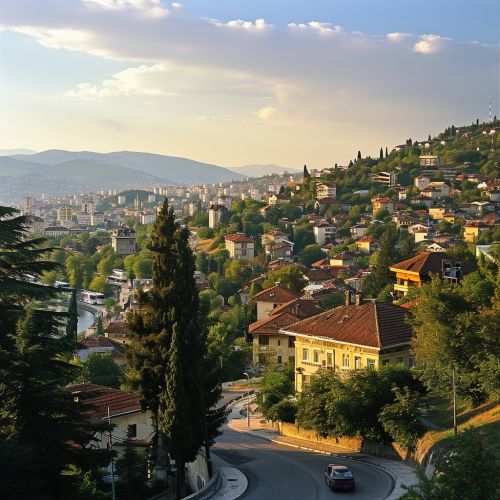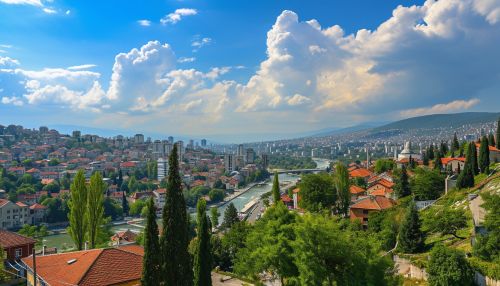Sarajevo
Geography
Sarajevo is the capital and largest city of Bosnia and Herzegovina, with a population of 275,524 in its administrative limits. It is nestled within the greater Sarajevo Canton region, which boasts a population of 413,593. The city is located in the southeastern part of the European continent, on the Balkan Peninsula.


The city is situated 518 meters (1,699 ft) above sea level and lies in the Sarajevo valley, in the middle of the Dinaric Alps. The valley itself once formed a vast expanse of greenery, but gave way to urban expansion and development in the post-World War II era. The city is surrounded by heavily forested hills and five major mountains. The highest of these is Mount Bjelašnica, which reaches 2,067 meters (6,781 ft).
History
Sarajevo has a long and rich history dating back to the Neolithic age. The area was home to several Illyrian and Celtic civilizations during the ancient times, and was part of the Roman and Byzantine Empires in the early centuries AD.
In the 15th century, the Ottoman Empire conquered Sarajevo and left a significant mark on the city. The Ottomans introduced Islam to Bosnia and Herzegovina, and over the centuries, mosques, bridges, and fountains were constructed throughout the city.
In 1878, Sarajevo was occupied by Austria-Hungary. This period brought the westernization of Sarajevo, with the introduction of railways, factories, and tramways.
Sarajevo was the site of the assassination of Archduke Franz Ferdinand of Austria in 1914, which led to the start of World War I. The city experienced severe damage during the two World Wars.
In the late 20th century, Sarajevo hosted the 1984 Winter Olympics. But, the city is perhaps best known for enduring the longest siege in modern military history during the Bosnian War in the 1990s.
Culture
Sarajevo is a city where East meets West. Its rich history of religious and cultural diversity has earned the city the nickname, "The Jerusalem of Europe". It is one of the few cities in the world to have a mosque, Catholic church, Orthodox church, and synagogue within the same neighborhood.
The city is famous for its traditional cultural and music events. The most popular of these is the Sarajevo Film Festival, which has become the largest and most famous film festival in the Balkans and Southeast Europe.
Sarajevo's music scene includes the traditional Bosnian folk music, known as sevdalinka, as well as modern pop, rock, and jazz genres. The city is home to the Sarajevo Philharmonic Orchestra, which is one of the oldest and most respected orchestras in the region.
Economy
Sarajevo's economy was historically based on industries such as tobacco, carpets, leather, and aircraft. However, the city's economy has transitioned to a focus on tourism, banking, and IT services.
The city is home to the headquarters of many Bosnian companies and government institutions. It is also the economic center of Bosnia and Herzegovina, with a GDP per capita that is significantly higher than the national average.
Education
Sarajevo is the main center of higher education in Bosnia and Herzegovina. It is home to the University of Sarajevo, which is the oldest and largest university in the country. The university offers a wide range of courses in sciences, arts, and social sciences.
There are also several international schools in Sarajevo, catering to the city's expatriate community. These include the International School of Sarajevo and the French International School of Sarajevo.
